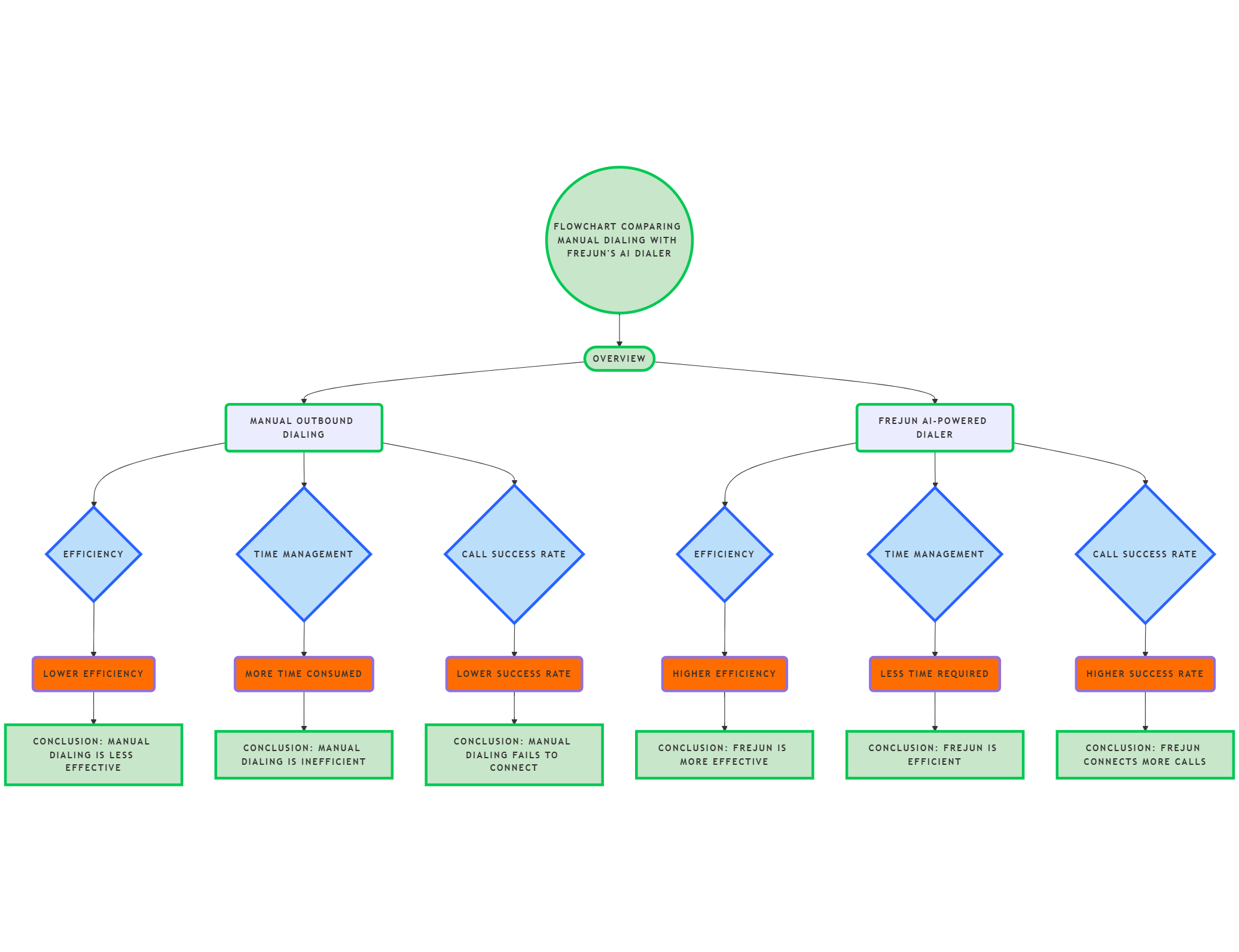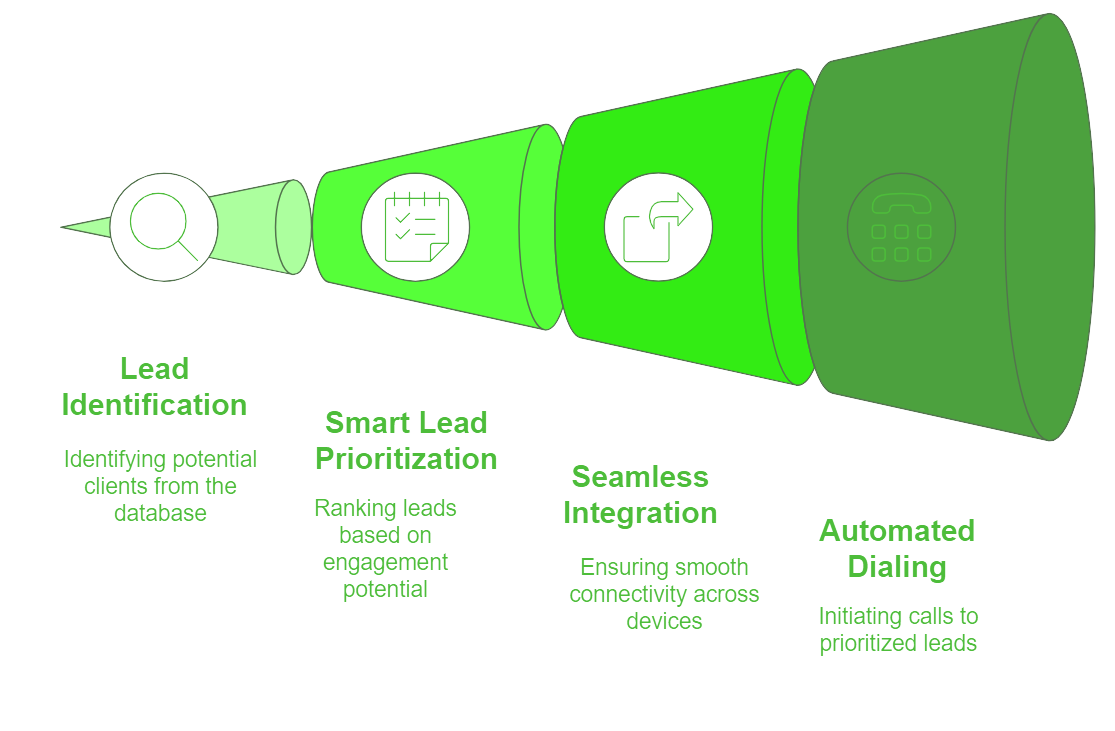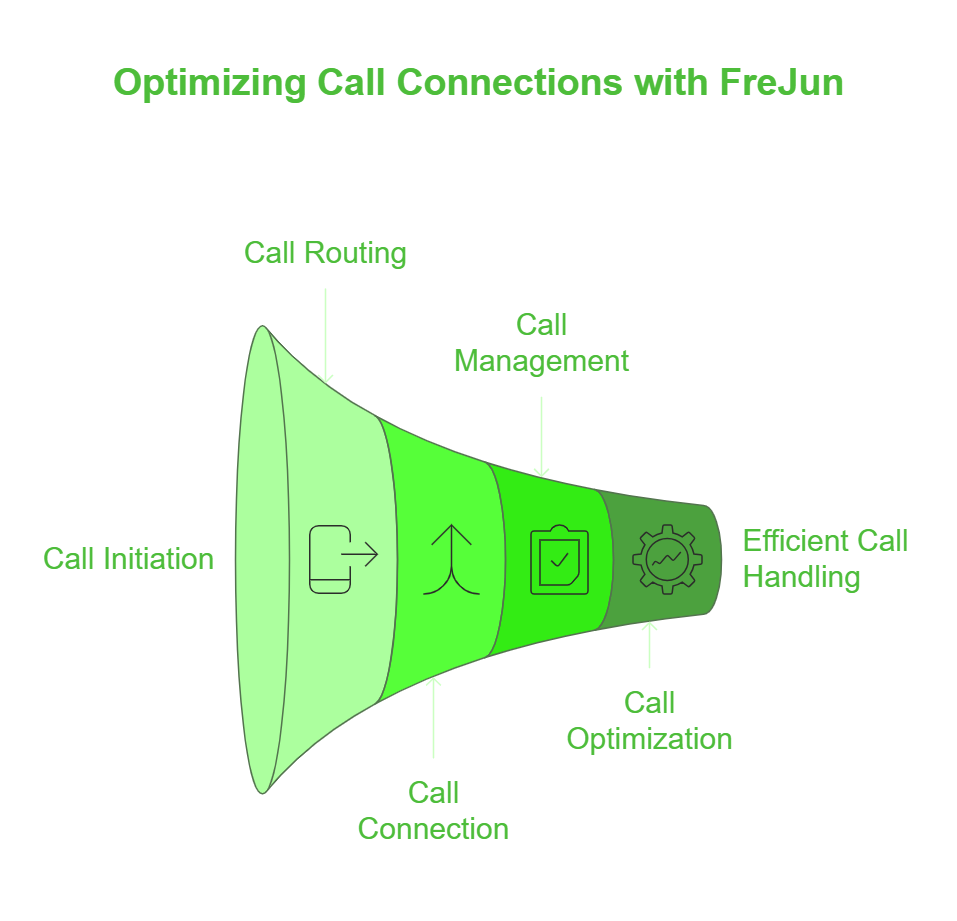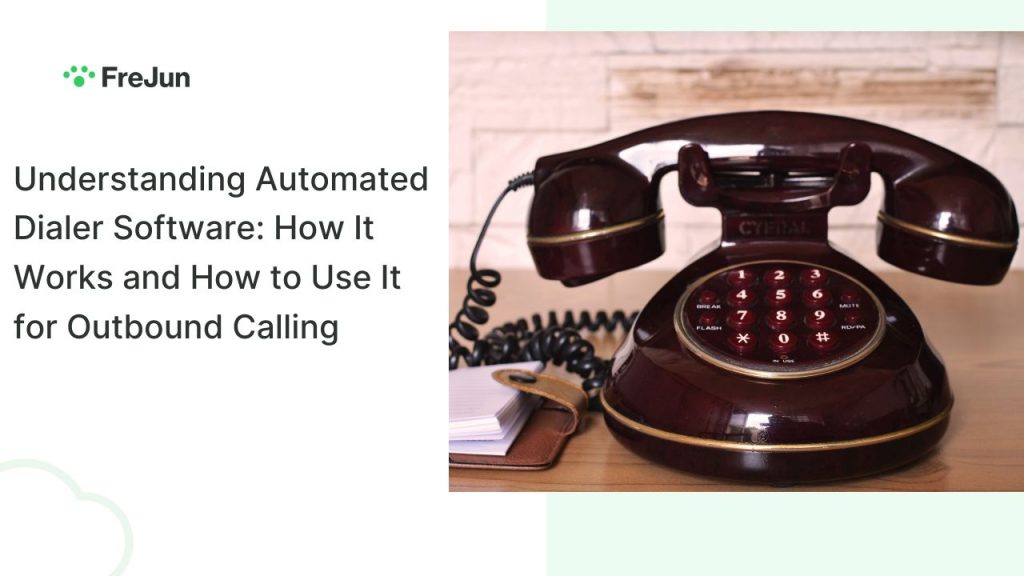Last updated on April 24th, 2025 at 03:11 pm
Automated Dialer Software, also known as autodialer or dialer software, is a powerful tool that helps businesses streamline their outbound calling processes. This software automates the dialing process, in 2025 making it faster and more efficient for agents to connect with customers. But what exactly is automated dialer software and how does it work? In this article, we will explore the inner workings of this technology and discuss how it can be used for outbound calling.
Automated dialer software has transformed outbound calling by improving efficiency, reducing wait times, and enhancing customer interactions. With AI-driven advancements, businesses can automate call processes, streamline lead management, and increase productivity.
Table of Contents
- What is Automated Dialer Software ?
- Feature and Importance of Automated Dialer Software
- AI-Powered Client Connection
- The Inner Workings of Automated Dialer Software
- Using Automated Dialer Software for Outbound Calling
- Choosing the Right Automated Dialer Software
- The Impact of Automated Dialer Software on Business Efficiency
- Conclusion
- Frequently Asked Questions
What is Automated Dialer Software ?
In 2025, businesses need AI-powered solutions to optimize outbound calling. Automated dialers reduce manual dialing, minimize idle time, and improve customer engagement, making them essential for sales, support, and marketing teams.
What is an Automated Dialer Software?
Automated dialer software is a computer program that revolutionizes the way businesses handle outbound calls. By automating the dialing process, this software enables organizations to reach a large number of contacts efficiently. It works by dialing phone numbers from a pre-defined list, saving agents valuable time and effort that would otherwise be spent on manual dialing.
Additionally, automated dialer software is equipped with a range of features designed to optimize call management and enhance agent productivity. These features may include call recording, call routing, and real-time analytics, providing businesses with valuable insights into their calling operations.
The Importance of Automated Dialer Software

Feature and Importance of Automated Dialer Software
| Feature | Importance in 2025 |
| AI-Based Call Prioritization | Essential |
| Answering Machine Detection | High |
| Call Analytics & Reports | Must-Have |
| Compliance Management | Critical |
In today’s competitive business landscape, speed and efficiency are key factors in achieving success. Automated dialer software plays a crucial role in helping businesses maximize their outbound calling efforts. By enabling agents to connect with more prospects in less time, the software significantly boosts productivity and performance.
Furthermore, automated dialer software is instrumental in ensuring compliance with telemarketing regulations. With built-in functionalities like Do-Not-Call (DNC) list management and call recording, businesses can uphold legal requirements and maintain a positive reputation in the industry.
Overall, the adoption of automated dialer software represents a strategic investment for organizations seeking to streamline their outbound calling processes and drive superior outcomes with greater efficiency. By leveraging the capabilities of this technology, businesses can stay ahead of the curve and achieve their communication goals effectively.
AI-Powered Client Connection

The Inner Workings of Automated Dialer Software
One of the main reasons why automated dialer software is so effective is its wide range of features.
Key Features of Automated Dialer Software
These features aim to simplify the calling process and maximize agent productivity. Some of the key features include:
- Auto-Dialing: The software automatically dials phone numbers from a designated list, eliminating the need for manual dialing.
- Call Routing: Calls can be routed to the most appropriate agent based on predefined rules, ensuring efficient call distribution.
- Call Scripting: Agents can access pre-written scripts to ensure consistency and provide accurate information during calls.
- Call Recording: The software can record calls for quality assurance, training purposes, or compliance requirements.
- Real-time Analytics: Managers can access real-time reports and analytics to monitor agent performance, campaign effectiveness, and make informed decisions.
These features work together to create a seamless and efficient calling experience. For example, the auto-dialing feature saves agents valuable time by eliminating the need to manually dial numbers. This allows them to focus on engaging with customers and providing excellent service.
Additionally, call routing ensures that calls are directed to the most appropriate agent, based on factors such as skillset, availability, or language proficiency. This not only improves customer satisfaction but also optimizes agent productivity by matching them with calls that align with their expertise.
How Automated Dialer Software Connects Calls

When it comes to connecting calls, automated dialer software utilizes different dialing modes based on the specific needs and requirements of the business.
The most common dialing modes include:
- Preview Dialing: Agents have the opportunity to preview the call details before dialing the number. This mode is often used for complex or high-value calls.
- Power Dialing: The software automatically dials the next number as soon as the agent is available. It is a suitable option for high-volume calling.
- Progressive Dialing: The software dials the next number in the list as soon as the agent finishes the previous call, maximizing agent efficiency.
- Predictive Dialing: This mode uses algorithms to predict agent availability and customer answer rates. It dials multiple numbers simultaneously, connecting agents only to live calls. Predictive dialing is ideal for large-scale outbound campaigns.
Each dialing mode serves a specific purpose and is designed to optimize the calling process. For instance, preview dialing allows agents to familiarize themselves with the call details, enabling them to provide personalized and tailored responses to customers.
On the other hand, predictive dialing leverages advanced algorithms to predict the availability of agents and the likelihood of customers answering the call. By dialing multiple numbers simultaneously, it minimizes agent idle time and maximizes the number of live connections, making it an efficient choice for large-scale outbound campaigns.
Using Automated Dialer Software for Outbound Calling
Implementing automated dialer software requires careful planning and setup to ensure smooth operations.
Setting Up Your Automated Dialer Software
The following steps can help businesses set up their automated dialer software:
- Define Objectives: Clearly define the objectives of your outbound calling campaign. Identify the target audience, set specific goals, and outline the desired outcomes.
- Compile Contact List: Create a comprehensive and up-to-date contact list for your campaign. Ensure that your list adheres to relevant privacy and data protection regulations.
- Customize Dialing Modes: Choose the dialing modes that align with your specific campaign requirements. Customize settings such as call pacing and retry attempts.
- Configure CRM Integration: Integrate your automated dialer software with your customer relationship management (CRM) system to streamline data management and improve agent efficiency.
- Train Agents: Provide thorough training to your agents on how to effectively use the automated dialer software. Familiarize them with features, call scripts, and best practices for outbound calling.
Setting up your automated dialer software is just the beginning. To ensure the success of your outbound calling campaigns, it is important to implement effective strategies that maximize the outcomes. Here are some strategies to consider:
- Segment Your Audience: Divide your contact list into relevant segments based on criteria such as demographics, buying behavior, or previous interactions. This allows you to tailor your approach and messaging for each segment.
- Personalize Your Communication: Use the data available to personalize your interactions with customers. Address them by name and reference any previous interactions or purchases to build rapport.
- Offer Value: Provide value to your customers during each call. Whether it’s offering a special promotion or addressing their pain points, make sure that each interaction is meaningful and beneficial.
- Monitor Performance: Continuously monitor campaign performance through real-time analytics provided by your automated dialer software. Make necessary adjustments to optimize your campaigns and improve outcomes.
- Follow-up: Don’t forget about the follow-up process. Plan and implement effective follow-up strategies to nurture leads, close sales, and build long-term relationships with customers.
Segmenting your audience is a crucial step in outbound calling. By dividing your contact list into relevant segments, you can tailor your approach and messaging to suit the specific needs and preferences of each group. For example, if you’re targeting a younger demographic, you may want to focus on social media marketing and use language and visuals that resonate with that age group.
Personalization is another key aspect of effective outbound calling. By using the data available to you, such as previous interactions or purchases, you can address customers by name and reference specific details that show you value their business. This personal touch helps build rapport and increases the chances of a successful interaction.
Offering value during each call is essential to keep customers engaged and interested. Whether it’s providing a special promotion or addressing their pain points, make sure that every interaction is meaningful and beneficial. This not only helps you achieve your objectives but also leaves a positive impression on the customer, increasing the likelihood of future business.
Monitoring campaign performance is crucial to ensure that your outbound calling efforts are yielding the desired results. With real-time analytics provided by your automated dialer software, you can track key metrics such as call success rates, conversion rates, and customer satisfaction. This data allows you to make informed decisions and make necessary adjustments to optimize your campaigns and improve outcomes.
Finally, don’t underestimate the power of follow-up. Implementing effective follow-up strategies is essential to nurture leads, close sales, and build long-term relationships with customers. Whether it’s sending personalized emails, making follow-up calls, or providing additional resources, a well-executed follow-up plan can significantly impact the success of your outbound calling campaigns.
Choosing the Right Automated Dialer Software
When it comes to choosing the right automated dialer software for your business, there are several key factors that you need to consider. These factors can make a significant difference in the effectiveness and efficiency of your dialing operations.
1) Factors to Consider When Selecting Dialer Software
- Scalability: One of the most important factors to consider is the scalability of the software. You want to ensure that the software can accommodate your business’s growth and changing needs. This means that it should be able to handle increasing call volumes and adapt to any changes in your business operations.
- Compatibility: Another crucial factor is the compatibility of the software with your existing systems. It’s essential to verify if the software integrates seamlessly with your CRM or call center software. This integration can streamline your operations and provide a more cohesive experience for your agents.
- Security: Data security is of utmost importance in today’s digital landscape. When selecting dialer software, it’s crucial to prioritize data security and compliance with regulations to protect customer information. Look for software that offers robust security features, such as encryption and secure data storage.
- User-Friendliness: The usability of the software is another critical factor to consider. You want to look for software that is intuitive and easy for agents to learn and use. A user-friendly interface can significantly improve agent productivity and reduce training time.
- Support and Training: Lastly, it’s essential to assess the level of support and training provided by the software provider. A smooth implementation process is crucial for the success of your dialing operations. Look for a provider that offers comprehensive support and training resources to ensure that your team can make the most out of the software.
2) Understanding Different Types of Dialer Software
Now that we have explored the key factors to consider when selecting dialer software, let’s delve into the different types of automated dialer software available in the market. Understanding these types can help you determine which one is best suited for your business needs. Here are the main types of dialer software:
- Preview Dialer: This type of dialer gives agents full control over each call. Before dialing, agents can view customer information, allowing them to personalize their approach and provide a more tailored experience.
- Power Dialer: The power dialer software dials a preset number of lines simultaneously and only connects the agent to answered calls. This type of dialer is ideal for high-volume outbound calling, as it maximizes agent productivity by minimizing idle time.
- Progressive Dialer: Similar to power dialing, the progressive dialer automatically adjusts the call pacing based on agent availability. This ensures a steady flow of calls while preventing agents from becoming overwhelmed or idle.
- Predictive Dialer: The predictive dialer takes efficiency to the next level. Using advanced algorithms, this type of dialer predicts agent availability and dials multiple lines at once. By minimizing wait times and optimizing call connections, predictive dialers can significantly increase agent efficiency and productivity.
By understanding the different types of dialer software and considering the key factors mentioned earlier, you can make an informed decision when selecting the right automated dialer software for your business. Remember, the right software can make a world of difference in improving your outbound calling operations and driving better results.
The Impact of Automated Dialer Software on Business Efficiency
These are the impacts of Automated Dialer Software on Business Efficiency:
1) Improving Productivity with Automated Dialer Software
Automated dialer software significantly improves productivity within a business. By automating the dialing process and providing features that enhance call management, agents can make a higher number of calls in less time. This increase in efficiency allows businesses to reach more potential customers and generate more leads or sales.
Moreover, automated dialer software helps reduce agent idle time by efficiently routing calls and making sure agents are connected only to live calls. The software also enables agents to access call scripts, customer information, and real-time analytics, further streamlining the calling process.
With automated dialer software, businesses can also take advantage of advanced features such as call recording and call monitoring. These features allow supervisors to listen to and evaluate calls, providing valuable feedback to agents for improvement. This not only enhances the quality of customer interactions but also contributes to the overall growth and development of the business.
2) Cost-Benefit Analysis of Using Dialer Software
When considering the adoption of automated dialer software, businesses need to conduct a cost-benefit analysis to understand the potential return on investment. While the initial cost of implementing the software may vary depending on the provider and the chosen features, the benefits can outweigh the expenses in the long run.
The increased productivity and efficiency resulting from the use of automated dialer software can lead to higher sales or conversion rates. Additionally, the software helps businesses save time and resources by automating manual dialing tasks and streamlining call management processes. This ultimately reduces costs associated with labor and manual errors.
Furthermore, automated dialer software offers scalability, allowing businesses to easily expand their calling operations as their needs grow. Whether it’s adding more agents or targeting new markets, the software can adapt to changing business requirements, providing a flexible and cost-effective solution.
Conclusion
In conclusion, automated dialer software revolutionizes outbound calling by automating the dialing process and enhancing agent productivity. When used effectively, businesses can achieve better results in less time. By understanding the inner workings of automated dialer software, setting it up effectively, utilizing effective strategies, and choosing the right software for your business, you can leverage this technology to drive business efficiency and success.
By leveraging FreJun and other advanced automated dialers, businesses can ensure optimized outbound calling, higher conversion rates, and increased productivity in 2025!
Further Reading: 11 Cloud Phone Systems Revolutionizing Business Communication
Frequently Asked Questions
It automatically dials a list of numbers and connects answered calls to available agents. FreJun provides intelligent auto-dialing to maximize agent efficiency.
Common types include predictive, progressive, preview, and power dialers. FreJun offers flexible options to suit various business needs.
A predictive dialer uses algorithms to call multiple numbers at once and routes answered calls to free agents. FreJun uses real-time data to ensure accurate call timing.
They reduce idle time and increase live connections. FreJun helps teams handle more calls per hour with consistent performance tracking.
Yes, it is scalable and improves call handling even with fewer agents. FreJun is a great fit for startups and growing sales teams.
Yes, most support CRM integrations to streamline workflows. FreJun integrates seamlessly with top CRM platforms to boost lead tracking.
A stable broadband connection is recommended. FreJun works efficiently on moderate internet connections, ensuring reliable call quality.
Subhash is the Founder of FreJun, the global call automation platform. With 8+ years of entrepreneurial experience, FreJun was established to help customers with their voice communication needs. The goal of FreJun is to develop cutting edge technology and solutions to help customers.
